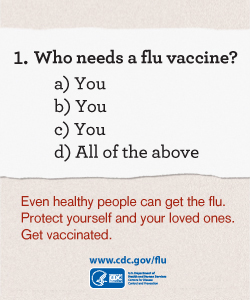Influenza
Influenza (also known as the flu) is a contagious respiratory illness caused by flu viruses. It can cause mild to severe illness, and at times can lead to death. The flu usually comes on suddenly.
Influenza (also known as the flu) is a contagious respiratory illness caused by flu viruses. It can cause mild to severe illness, and at times can lead to death. The flu usually comes on suddenly.

People who have the flu often feel some or all of these signs and symptoms:
Most experts believe that flu viruses spread mainly by droplets made when people with flu cough, sneeze or talk. These droplets can land in the mouths or noses of people who are nearby. Less often, a person might also get flu by touching a surface or object that has flu virus on it and then touching their own mouth, eyes or possibly their nose. It is possible to spread the virus without knowing you are sick.
An annual seasonal flu vaccine (either the flu shot or the nasal spray flu vaccine) is the best way to reduce the chances that you will get seasonal flu and spread it to others. When more people get vaccinated against the flu, less flu can spread through that community.
Usually, you’ll need nothing more than bed rest and plenty of fluids to treat the flu. However if the case is serious enough your doctor can prescribe antiviral drugs that can be used to treat the flu.
5% TO 20%PERCENTAGE OF U.S. POPULATION THAT WILL GET THE FLU, ON AVERAGE, EACH YEAR.
200,000AVERAGE NUMBER OF AMERICANS HOSPITALIZED EACH YEAR BECAUSE OF PROBLEMS WITH THE FLU.
3,000 TO 49,000NUMBER OF PEOPLE WHO DIE EACH YEAR FROM FLU-RELATED CAUSES IN THE U.S.